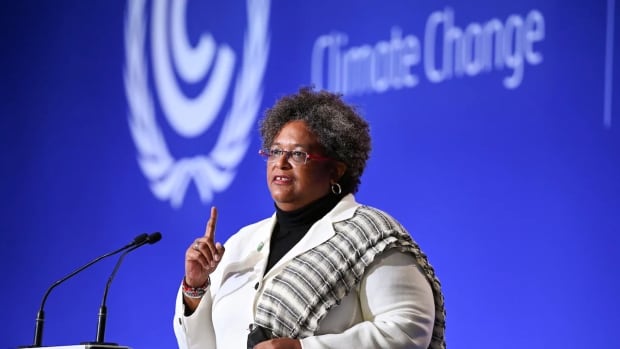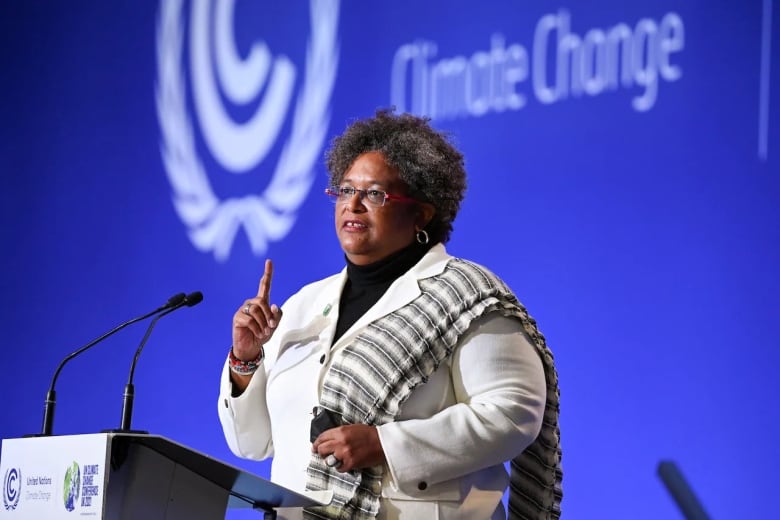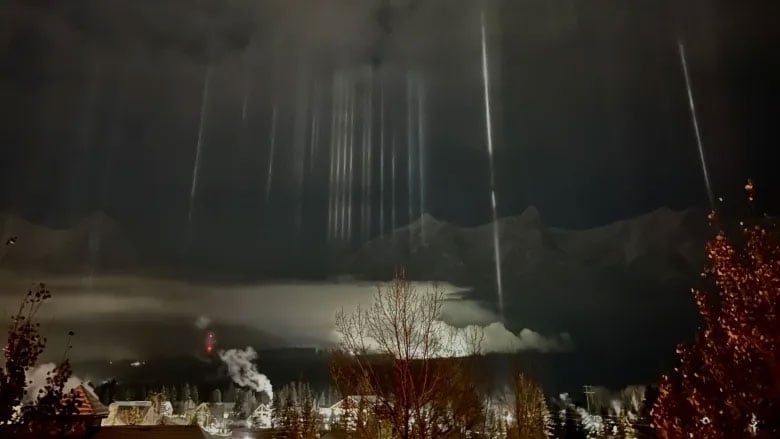
Our planet is changing. So is our journalism. This weekly newsletter is part of a CBC News initiative entitled “Our Changing Planet” to show and explain the effects of climate change. Keep up with the latest news on our Climate and Environment page.
Sign up here to get this newsletter in your inbox every Thursday.
This week:
- What is the fossil fuel non-proliferation movement?
- Look, up in the sky! Light pillars!
- Biodiversity needs same protection as climate, say scientists, activists at COP27
What is the fossil fuel non-proliferation movement?

What On Earth18:17What is a fossil fuel non-proliferation treaty?
One hallmark of global climate summits in recent years is the call from activists to wind down fossil fuel use. But at this year’s COP27 in Sharm el-Sheikh, Egypt, leaders from some island countries are adding their voices to that chorus, urging world leaders to adopt a Fossil Fuel Non-Proliferation Treaty.
“More fossil fuel extraction means more loss and damage experienced by our island homes,” said Samoan climate activist Brianna Fruean, speaking at COP27. “A COP that does not address fossil fuels is a COP that does not address the root cause of the climate crisis, and a COP that is complicit in the devastation of my people.”
The Fossil Fuel Non-Proliferation Treaty is a proposed international agreement to end all new exploration and production of fossil fuels and phase out existing production of fossil fuels to reach the 1.5 C global climate target.
The campaign cites a recent study in the journal Nature that found nearly 60 per cent of oil and methane gas and 90 per cent of coal must stay in the ground to meet that target. The proposed treaty also calls for governments to pursue a just transition to renewable energy for all workers globally.
The Pacific island country of Tuvalu called for a Fossil Fuel Non-Proliferation Treaty in the opening days of COP27, the first time a country has done so at an international climate conference. Tuvalu was only the second country ever to publicly make such a demand, following neighbouring Vanuatu, which called for it in September.
The treaty has the support of international organizations such as the World Health Organization and the Vatican. The European Parliament endorsed the proposal in October, encouraging its member states to work on developing it. Seventy cities and subnational governments worldwide have also signed on to support the treaty, along with thousands of scientists, academics, researchers and faith leaders.
The fossil fuel industry has earned huge profits this year — in part because of energy shortages caused by Russia’s invasion of Ukraine — a fact that has drawn the attention of world leaders and raised questions at COP27 over whether those profits should be used to pay for the costs of climate change.
At the opening of the conference, the prime minister of Barbados, Mia Mottley (photo above), called on oil and gas companies to contribute 10 cents of every dollar of profit to a fund to help poor countries recover from climate change-linked disasters. “This is what our people expect,” she said.
Growing international pressure on the fossil fuel industry included sharp words from UN Secretary General António Guterres, who raised the issue of “bogus net-zero pledges” at the release of a new report on the net zero commitments made by companies, financial institutions, cities and regions.
Net zero pledges by companies are of prime importance to Catherine McKenna, the former Canadian federal environment minister and current head of the expert group that wrote the report. The report offers recommendations for how to ensure those promises are met, including tackling greenwashing through government regulation.
When it comes to net zero promises made by companies, McKenna told What On Earth host Laura Lynch that it’s hard “to track exactly how folks are doing, because they aren’t reporting transparently.”
One of the recommendations in the report is for the UN to create a publicly accessible Global Climate Action Portal, where companies must report their progress annually with independently verified figures.
At the same time, more than 600 fossil fuel lobbyists were registered to attend COP27, according to one advocacy group.
What On Earth requested interviews with representatives from the industry about the demands for a phase-down of fossil fuels. Pathways Alliance, an organization representing oilsands companies, initially agreed, then cancelled, and later did an interview with CBC Radio’s The House. It sent a written statement saying it is in Sharm el-Sheikh to showcase plans for carbon capture and storage in Alberta, part of its plan to get to net zero by 2050.
The Canadian Association of Petroleum Producers (CAPP) declined an interview request. In response to questions about the call for fossil fuel companies to compensate vulnerable countries with part of the profits they’ve made this year, CAPP sent a written statement saying its members are paying increased royalties to the Canadian government because of higher oil and gas prices, and that the government can determine the best use of those funds.
CAPP also said “global demand for natural gas and oil will remain strong for decades and Canada has a role to play in providing safe and lower-emission resources to the world’s energy mix.”
But McKenna said fossil fuel development must end as soon as possible if the world is to reach its climate goals. “That’s the science from the IPCC,” she said, emphasizing that modelling from the International Energy Agency “shows that as well.”
She said Canada, like Europe, ultimately needs to move toward regulating large companies in order to meet national climate targets.
“Governments need to step up,” she said. “The laws requiring this will really drive this change. And, gosh, we need it.”
— Rachel Sanders
Reader feedback
Paul Peckford:
“Thanks for the many informative articles, especially those regarding climate change and the many terrible negative effects it has on our daily lives no matter where we dwell! The horrible effects of pollution are closely tied to many areas of climate change as well! I am amazed by the number of people who are climate change deniers despite all of the credible scientific knowledge to support its existence and related negative impacts!”
Old issues of What on Earth? are right here.
CBC News has a dedicated climate page, which can be found here.
Also, check out our radio show and podcast. Can you put a price on a park? It’s been a year since devastating flooding and deadly landslides hit B.C. This week on What On Earth, we hear why Edmonton is leading the charge in Canada on a “climate budget,” and head to Oslo, Norway, to find out how theirs has led to some big changes. What On Earth now airs on Sundays at 11 a.m. ET, 11:30 a.m. in Newfoundland and Labrador. Subscribe on your favourite podcast app or hear it on demand at CBC Listen.
The Big Picture: Light pillars
When Ryota Suyama woke up around 4 a.m. on a recent Tuesday, it looked like an alien invasion had taken over the town of Canmore, Alta., as columns of light shot into the night sky. “It was kind of surreal,” Suyama said. “We’ve seen … northern lights a couple of times, but we had never seen light pillars before.”
The columns of light were actually visible from Spruce Grove to Calgary. Called light pillars, they occur on very cold, clear evenings when tiny ice crystals form in the atmosphere, according to Jeroen Stil, associate professor in the department of physics and astronomy at the University of Calgary. You need temperatures below about –20 C for the ice crystals to form, Stil says, although Roland Dechesne, past president of the Royal Astronomical Society of Canada’s Calgary centre, says he’s seen them at about –11 C.
In an interview on the Calgary Eyeopener, Stil said it’s not technically a pillar of light — “it’s actually an optical illusion.”
On calm evenings, the crystals hang at just the right angle to act as small mirrors reflecting any light beaming up at them from below, such as a street lamp or lighting on a commercial building. Like a rainbow, you could never get closer to or move through these columns of light, Stil says. The ice crystals hang about halfway between your eyes and the pillar, so if you move, the look of the illusion will change.
— Taylor Simmons

Hot and bothered: Provocative ideas from around the web
Biodiversity needs same protection as climate, say scientists, activists at COP27

Civil society groups, Indigenous activists and scientists are standing together at the COP27 climate conference in Egypt and demanding firm action be taken next month at the UN Biodiversity Conference that will be hosted in Montreal.
That conference aims to get governments to agree on a framework to “bring about a transformation in society’s relationship with biodiversity,” which is in rapid decline worldwide because of climate change and other factors.
“The climate and biodiversity crises are deeply interconnected and must be addressed simultaneously,” said Lucy Almond, chair of the Nature 4 Climate Coalition, a group of 20 organizations, including the World Wildlife Fund and World Resources Institute.
She called COP15 in Montreal a once-in-a-decade opportunity to create an international agreement that will set out to tackle both crises together.
The key architects of the 2015 Paris Agreement — Christiana Figueres, Laurence Tubiana, Laurent Fabius and Manuel Pulgar-Vidal — have added their voices to the calls for COP15 to create a sister agreement.
Currently, the planet is seen to be on the brink of the sixth mass extinction event — the first triggered by humans — with approximately one million species already at risk of extinction.
Biodiversity loss is happening because of habitat destruction, pollution, over-exploitation and other reasons — and is forecast to accelerate because of the destabilizing effects climate change is having on planetary systems.
Research published this year in the journal Science found that if the planet exceeds 1.5 C of warming above pre-industrial levels, that could begin triggering irreversible effects around the planet, called tipping points.
As the name suggestions, a tipping point isn’t a gradual change as the temperature increases, like a slowly melting glacier. Rather, the researchers forecast that at certain thresholds, the Greenland ice sheet is likely to collapse, coral reefs will rapidly die off and so on. Scientists have identified 16 of these systems that are responsible for maintaining the planet’s natural equilibrium, but those systems are destabilizing as the planet warms.
“Sometimes in COP negotiations, people don’t talk much about the risks [of tipping points],” said Carlos Nobre, an Earth system scientist from Brazil’s University of São Paulo. He noted how the loss of tropical forests would trigger the release of enormous amounts of greenhouse gases, warming the planet further and setting off a nasty feedback loop.
“We have to avoid those tipping points. Otherwise, in the 22nd century, the temperature will be without control,” Nobre said.
Among the 16 critical tipping points is the potential collapse of Arctic sea ice, which would have a devastating impact on the entire Arctic ecosystem, said Johan Rockstrom, the director of the Potsdam Institute for Climate Research.
He also underlined just how close to home this could hit for all Canadians, saying it’s possible to draw a line from sea ice melt to the town of Lytton, B.C., burning in the summer of 2021.
Melting sea ice is impacting all Arctic species, he said, but it’s also connected to other tipping point systems in different parts of the world, specifically shifting the polar jet stream from its normal equilibrium.
“The terrible summer in British Columbia last year … that was an omega blockage of the jet stream, related to the Arctic melting,” said Rockstrom.
Since the last Ice Age, the world has been ideal for human, animal and plant life, he said, but we’re seeing potential for the dominoes to start falling. “Because when you cross a tipping point, things get irreversible and irreversibility means that we drift off toward a less and less livable planet,” said Rockstrom.
Indigenous people are on the front lines of climate impacts — including in the Amazon rainforest. Helena Gualinga, an Indigenous activist from Ecuador, spoke Wednesday in Egypt of the need for governments to take responsibility for their role in ecosystem destruction and allow for Indigenous voices to help heal the damage.
Gualinga also pointed out that 80 per cent of the world’s biodiversity is held on land controlled by Indigenous people, who only represent five per cent of the world’s population. In her community, she said, there are only 1,200 people but they’ve taken on a stewardship role protecting 144,000 hectares of the Amazon.
“There is a reason for that, and it’s the philosophy and mindset and culture and relationship that Indigenous people have to nature.”
The UN biodiversity conference is held every 10 years — with this iteration delayed two years by the pandemic — and has a lower profile. But Almond said COP15 will be a defining moment for how we as a society address the challenge.
“The science is definitive: we’re losing biodiversity at the fastest rate in human history.”
— Sarah Lawrynuik
Stay in touch!
Are there issues you’d like us to cover? Questions you want answered? Do you just want to share a kind word? We’d love to hear from you. Email us at [email protected].
Sign up here to get What on Earth? in your inbox every Thursday.
Editor: Andre Mayer | Logo design: Sködt McNalty